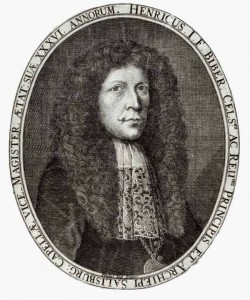 Heinrich Ignaz Franz von Biber is celebrated as one of the first great composers of virtuosic music for the violin. As an artist working in seventeenth-century Austria, he was a unique creative force, composing works that were not only technically challenging, but grounded in the intellectual and theological concerns of his time. Biber wrote of his “faith in stringed instruments,” a phrase whose multi-faceted meaning invites contemplation as one encounters his body of work for the instrument.
Heinrich Ignaz Franz von Biber is celebrated as one of the first great composers of virtuosic music for the violin. As an artist working in seventeenth-century Austria, he was a unique creative force, composing works that were not only technically challenging, but grounded in the intellectual and theological concerns of his time. Biber wrote of his “faith in stringed instruments,” a phrase whose multi-faceted meaning invites contemplation as one encounters his body of work for the instrument.
My program presents music from two significant collections of works for violin and continuo by Biber, the most alluring of which is the “Mystery” Sonatas.
The “Mystery” (Rosary) Sonatas occupy a singular place in the repertoire. The collection is formed of fifteen sonatas for violin plus continuo (the bass instrument is unspecified by the composer) plus a passacaglia for unaccompanied violin, each sonata representing one of the Holy Mysteries of the Rosary. It is thought that the sonatas were played as postludes for services in Salzburg during the month celebrating the Rosary; practically speaking, their original function was to act as ‘musical ikons’, guiding the meditation of the faithful upon the mysteries. In the manuscript, each sonata is accompanied by an engraving depicting the mystery with which it is associated.
In this collection of sonatas, Biber employs the unusual scordatura technique, the deliberate re-tuning of the instrument in order to alter its resonance, drawing out timbral colors that it is not ordinarily possible to create. Tuning the strings to notes higher than their usual pitches places the instrument under stress, and the scordatura tunings with the most tension are reserved for the sonatas representing the Passion narrative, essentially mirroring the strain on the physical body of Jesus Christ using the instrument itself.
their original function was to act as ‘musical ikons’, guiding the meditation of the faithful upon the mysteries
My interest in the sonatas came from a curiosity about ritual.
It is thought that the “Mystery” Sonatas were composed for use by a Jesuit prayer society in seventeenth century Austria, where the faithful would contemplate the works as they meditated upon the mysteries of the Holy Rosary. My first performance of any of the Mystery Sonatas happened to be remarkably similar to this original intention: I performed the five sonatas that represent the Sorrowful Mysteries in a concert for members of an Anglo-Catholic church, following their ritual walking of the Stations of the Cross during Lent. In this context, the pieces were musical ikons, sacred portraits in sound.

That this was the beginning of my relationship with these pieces I consider to be a piece of great personal good fortune. Whatever one’s faith, the subject matter of the “Mystery” Sonatas invites contemplation of the strange and wonderful, of questions that cannot be answered, and of reality upturned. An important facet of our shared humanity is our capacity to bear doubt; contemplation of mystery has the power to remind us of our common strength and fragility.
In preparing to perform music from the Mystery Sonatas and other works by Biber this year, I keep this in mind. It is not my business to know the hearts of my audience, but I am inspired by the mystery.
Use the button below for tickets to Rebecca Harris’s recital.
